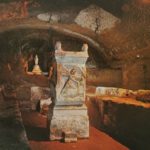One of my favorite experiences in Rome was exploring the Basilica of Saint Clement. Tami and I stumbled upon it in the few blocks between our room and the Colosseum. But as it seemed a fairly ordinary church for Rome, built around 1100, we passed by it a number of times before noticing a sign on the door inviting tourists to see what lay below. After descending a staircase some twenty feet down, we emerged amid the mosaics and fading frescoes of a fourth century church. More than the fact that it lay under the above church told us it was ancient. Rather than the renaissance realism found in the art above, the iconography here had a cartoonish quality typical of Ancient Rome. The church had clearly been in use a long time. At sometime in its history, several walls had been added by stacking ruble in the empty spaces between once decorative pillars. But centuries of debris outside eventually raised the ground level, entombing this space in subterranean silence. And yet it wasn’t the only building resting beneath the 12th century church.
We descended another set of stairs and entered the oldest building constructed on this spot, a series of twisted passageways and dimly lit rooms quite unlike the two churches above it. Here some thirty feet down, we could hear the sound of an underground stream echoing in its halls. To our left, we found the walled up archway that once opened to the street. And around the corner, the reason for the building, a room containing a large block of marble carved with a man grabbing a bull by the horns. It was an altar dedicated to the god Mithra. And on both sides was a typical Roman dining bench where the members of this cult would recline to share a meal in dedication to their god. All of this was destroyed in Rome’s Great Fire of 64AD and filled in.
















